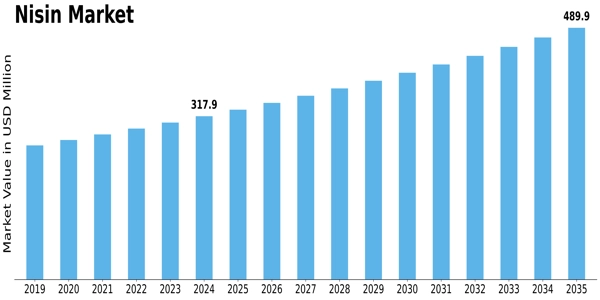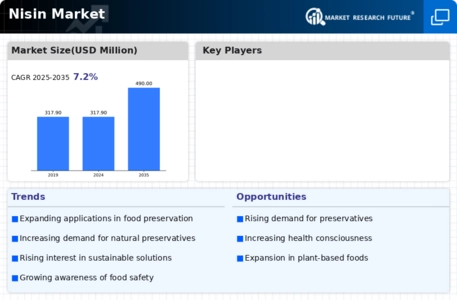-
EXECUTIVE SUMMARY
-
MARKET INTRODUCTION
-
Market Definition
-
Scope of the Study
- Research Objectives
- Assumptions & Limitations
-
Market Structure
-
MARKET RESEARCH METHODOLOGY
-
Research Process
-
Secondary Research
-
Primary Research
-
Forecast Model
-
MARKET LANDSCAPE
-
Supply Chain Analysis
- Raw Material Suppliers
- Manufacturers/Producers
- Distributors/Retailers/Wholesalers/E-Commerce
- End Users
-
Porter’s Five Forces Analysis
- Threat of New Entrants
- Bargaining Power of Buyers
- Bargaining Power of Suppliers
- Threat of Substitutes
- Internal Rivalry
-
MARKET DYNAMICS OF THE GLOBAL NISIN MARKET
-
Introduction
-
Drivers
-
Restraints
-
Opportunities
-
Challenges
-
GLOBAL NISIN MARKET, BY FORM
-
Introduction
-
Powder
- Market Estimates & Forecast, 2020–2027
- Market Estimates & Forecast, by Region, 2020–2027
-
Liquid
- Market Estimates & Forecast, 2020–2027
- Market Estimates & Forecast, by Region, 2020–2027
-
GLOBAL NISIN MARKET, BY APPLICATION
-
Introduction
-
Bakery & Confectionery
- Market Estimates & Forecast, 2020–2027
- Market Estimates & Forecast, by Region, 2020–2027
-
Dairy & Frozen Desserts
- Market Estimates & Forecast, 2020–2027
- Market Estimates & Forecast, by Region, 2020–2027
-
Beverages
- Market Estimates & Forecast, 2020–2027
- Market Estimates & Forecast, by Region, 2020–2027
-
Meat, Poultry & Seafood Products
- Market Estimates & Forecast, 2020–2027
- Market Estimates & Forecast, by Region, 2020–2027
-
Canned Products
- Market Estimates & Forecast, 2020–2027
- Market Estimates & Forecast, by Region, 2020–2027
-
Others
- Market Estimates & Forecast, 2020–2027
- Market Estimates & Forecast, by Region, 2020–2027
-
GLOBAL NISIN MARKET, BY REGION
-
Introduction
-
North America
- Market Estimates & Forecast, 2020–2027
- Market Estimates & Forecast, by Form, 2020–2027
- Market Estimates & Forecast, by Application, 2020–2027
- Market Estimates & Forecast, by Country, 2020–2027
- US
- Canada
- Mexico
-
Europe
- Market Estimates & Forecast, 2020–2027
- Market Estimates & Forecast, by Form, 2020–2027
- Market Estimates & Forecast, by Application, 2020–2027
- Market Estimates & Forecast, by Country, 2020–2027
- Germany
- UK
- France
- Spain
- Italy
- Rest of Europe
-
Asia-Pacific
- Market Estimates & Forecast, 2020–2027
- Market Estimates & Forecast, by Form, 2020–2027
- Market Estimates & Forecast, by Application, 2020–2027
- Market Estimates & Forecast, by Country, 2020–2027
- China
- Japan
- India
- Australia & New Zealand
- Rest of Asia-Pacific
-
Rest of the World
- Market Estimates & Forecast, 2020–2027
- Market Estimates & Forecast, by Form, 2020–2027
- Market Estimates & Forecast, by Application, 2020–2027
- Market Estimates & Forecast, by Region, 2020–2027
- South America
- Middle East
- Africa
-
COMPETITIVE LANDSCAPE
-
Introduction
-
Market Strategy
-
Key Development Analysis (Expansions/Mergers & Acquisitions/Joint Ventures/New Product Developments/Agreements/Investments)
-
COMPANY PROFILES
-
DSM
- Company Overview
- Financial Updates
- Product/Business Segment Overview
- Strategy
- Key Developments
- SWOT Analysis
-
Galactic
- Company Overview
- Financial Updates
- Product/Business Segment Overview
- Strategy
- Key Developments
- SWOT Analysis
-
DuPont
- Company Overview
- Financial Updates
- Product/Business Segment Overview
- Strategy
- Key Developments
- SWOT Analysis
-
Shandong Freda Biotechnology
- Company Overview
- Financial Updates
- Product/Business Segment Overview
- Strategy
- Key Developments
- SWOT Analysis
-
Siveele B.V.
- Company Overview
- Financial Updates
- Product/Business Segment Overview
- Strategy
- Key Developments
- SWOT Analysis
-
Cayman Chemicals
- Company Overview
- Financial Updates
- Product/Business Segment Overview
- Strategy
- Key Developments
- SWOT Analysis
-
Chihon Biotechnology
- Company Overview
- Financial Updates
- Product/Business Segment Overview
- Strategy
- Key Developments
- SWOT Analysis
-
Handary S.A.
- Company Overview
- Financial Updates
- Product/Business Segment Overview
- Strategy
- Key Developments
- SWOT Analysis
-
Zhejiang Silver-Elephant Bioengineering
- Company Overview
- Financial Updates
- Product/Business Segment Overview
- Strategy
- Key Developments
- SWOT Analysis
-
Mayasan Biotech
- Company Overview
- Financial Updates
- Product/Business Segment Overview
- Strategy
- Key Developments
- SWOT Analysis
-
CONCLUSION LIST OF TABLES
-
Global Nisin Market, by Region, 2020–2027 (USD Million)
-
Global Nisin Market, by Form, 2020–2027 (USD Million)
-
Global Nisin Market, by Application, 2020–2027 (USD Million)
-
North America: Nisin Market, by Country, 2020–2027 (USD Million)
-
North America: Nisin Market, by Form, 2020–2027 (USD Million)
-
North America: Nisin Market, by Application, 2020–2027 (USD Million)
-
US: Nisin Market, by Form, 2020–2027 (USD Million)
-
US: Nisin Market, by Application, 2020–2027 (USD Million)
-
Canada: Nisin Market, by Form, 2020–2027 (USD Million)
-
Canada: Nisin Market, by Application, 2020–2027 (USD Million)
-
Mexico: Nisin Market, by Form, 2020–2027 (USD Million)
-
Mexico: Nisin Market, by Application, 2020–2027 (USD Million)
-
Europe: Nisin Market, by Country, 2020–2027 (USD Million)
-
Europe: Nisin Market, by Form, 2020–2027 (USD Million)
-
Europe: Nisin Market, by Application, 2020–2027 (USD Million)
-
Germany: Nisin Market, by Form, 2020–2027 (USD Million)
-
Germany: Nisin Market, by Application, 2020–2027 (USD Million)
-
France: Nisin Market, by Form, 2020–2027 (USD Million)
-
France: Nisin Market, by Application, 2020–2027 (USD Million)
-
Italy: Nisin Market, by Form, 2020–2027 (USD Million)
-
Italy: Nisin Market, by Application, 2020–2027 (USD Million)
-
Spain: Nisin Market, by Form, 2020–2027 (USD Million)
-
Spain: Nisin Market, by Application, 2020–2027 (USD Million)
-
UK: Nisin Market, by Form, 2020–2027 (USD Million)
-
UK: Nisin Market, by Application, 2020–2027 (USD Million)
-
Rest of Europe: Nisin Market, by Form, 2020–2027 (USD Million)
-
Rest of Europe: Nisin Market, by Application, 2020–2027 (USD Million)
-
Asia-Pacific: Nisin Market, by Country, 2020–2027 (USD Million)
-
Asia-Pacific: Nisin Market, by Form, 2020–2027 (USD Million)
-
Asia-Pacific: Nisin Market, by Application, 2020–2027 (USD Million)
-
China: Nisin Market, by Form, 2020–2027 (USD Million)
-
China: Nisin Market, by Application, 2020–2027 (USD Million)
-
India: Nisin Market, by Form, 2020–2027 (USD Million)
-
India: Nisin Market, by Application, 2020–2027 (USD Million)
-
Japan: Nisin Market, by Form, 2020–2027 (USD Million)
-
Japan: Nisin Market, by Application, 2020–2027 (USD Million)
-
Australia & New Zealand: Nisin Market, by Form, 2020–2027 (USD Million)
-
Australia & New Zealand: Nisin Market, by Application, 2020–2027 (USD Million)
-
Rest of Asia-Pacific: Nisin Market, by Form, 2020–2027 (USD Million)
-
Rest of Asia-Pacific: Nisin Market, by Application, 2020–2027 (USD Million)
-
Rest of the World (RoW): Nisin Market, by Country, 2020–2027 (USD Million)
-
Rest of the World (RoW): Nisin Market, by Form, 2020–2027 (USD Million)
-
Rest of the World (RoW): Nisin Market, by Application, 2020–2027 (USD Million)
-
South America: Nisin Market, by Form, 2020–2027 (USD Million)
-
South America: Nisin Market, by Application, 2020–2027 (USD Million)
-
Middle East: Nisin Market, by Form, 2020–2027 (USD Million)
-
Middle East: Nisin Market, by Application, 2020–2027 (USD Million)
-
Africa: Nisin Market, by Form, 2020–2027 (USD Million)
-
Africa: Nisin Market, by Application, 2020–2027 (USD Million) LIST OF FIGURES
-
Global Nisin Market Segmentation
-
Forecast Research Methodology
-
Five Forces Analysis of the Global Nisin Market
-
Value Chain of the Global Nisin Market
-
Share of the Global Nisin Market in 2020, by Country (%)
-
Global Nisin Market, by Region, 2020–2027
-
Global Nisin Market Size, by Form,
-
Share of the Global Nisin Market, by Form, 2020–2027 (%)
-
Global Nisin Market Size, by Application,
-
Share of the Global Nisin Market, by Application, 2020–2027 (%)




Leave a Comment